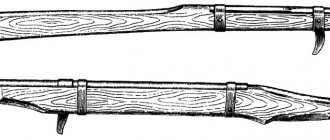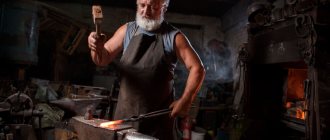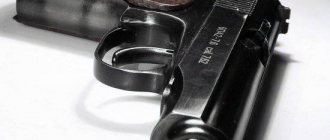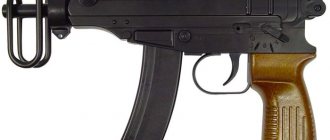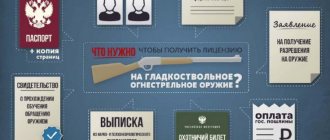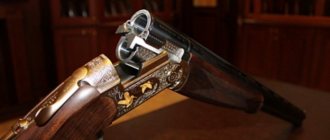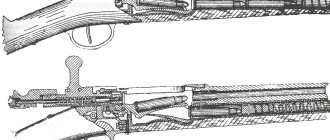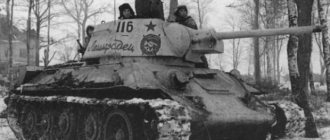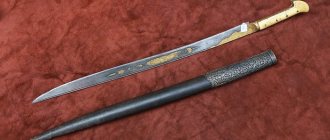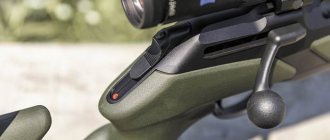Appearance of the MP-341 Howd pistol
First of all, I would like to say that this type of weapon is ideal for self-defense on a long trip in your own car, since in recent years, robbery attacks on drivers on highways have become increasingly common.
Being outside the city on the highway, it is useless to hope for someone’s help, so this weapon will be an excellent option for self-defense. Of course, the design of a weapon for self-defense is far from being its key characteristic; high combat performance, ease of use and reliability are much more important.
Almost all traumatic pistols are made very compact so that they can be carried concealed. The MP 341 was clearly not created according to this philosophy, becoming a record holder in size among trauma vehicles. Its length is 490 millimeters and its weight is 2.1 kilograms. It is precisely because of this that it will not be possible to carry it secretly, so self-defense with it is realistic only in cases where such a sawn-off shotgun does not have to be carried with you all the time.
You need to think about the problem of wearing it right away, even if you plan to carry it in a car. The fact is that even if your car is 100% protected from theft, you cannot leave the MP 341 in the car. In the event of an unexpected inspection, civil servants, after saying “I’ll get it from the car now,” will immediately take away your license and the pistol itself.
As for the design, this is a real sawn-off shotgun. There is not a single element here, except for the inscription “Howda,” that would give the enemy away that this is just a modest traumatic pistol. Experts believe that the basis was the famous IZH-43KN, which underwent impressive changes by the developers of the MP 341.
First of all, the length of the barrels was changed. The barrel arrangement system and their location were also changed so that no one could install the original IZH-43KN barrels. The design of the trunks itself has also changed, but externally this is in no way noticeable and does not spoil the appearance.
There are two main versions of this weapon - in a wooden case and in a plastic one. Of course, it is the version made of wood that is most valued by weapon lovers, because it is practically impossible to distinguish it from the original sawn-off shotgun. The plastic version has exactly the same dimensions as the wooden one, but has much less demand on the market. In addition, the barrels in this version are covered with a special material, which makes it much more difficult to remove the pistol.
Why do you need a rubber arrow?
Review of the traumatic pistol thunderstorm
As a rule, it is needed for self-defense, less often for recreational shooting. Also, first, figure out how often you will shoot from it. Owning a weapon must necessarily involve regular training with it. Naturally, you need to learn to shoot with it and constantly practice shooting. If you do not have time for regular shooting and training, I would not advise you to purchase any weapon, with the possible exception of a gas spray, because... pistol (revolver), gas or traumatic, gives FALSE confidence in one’s protection
And due to the fact that the RS is not a short-barreled firearm (in the full understanding of this phrase), it is very important not only to be able to quickly remove the weapon, but also to fire shots from it, hitting the most painful places of the person who attacked you. This can only be achieved through methodical training, and not only dry, without firing, but also with regular firing.
In this regard, we come to the first stage of selection:
1. Only weapons with a long service life are suitable for regular training.
In this case, only weapons made entirely of weapons-grade steel win.
2. Decide what you like best: a pistol or a revolver
The advantages of pistols are all known, these are
- Flat dimensions
- More rounds in the magazine and faster reloading (magazine changes) compared to revolvers
- Higher rate of fire compared to revolvers
- After the first shot, it is easier to aim and shoot, because... the trigger is already cocked, the trigger force is quite small.
The disadvantage of pistols is also known:
Possibility of “catching a wedge” as a result of cartridge misalignment. This is actually quite easy to avoid. It is enough to clean and lubricate your gun regularly.
Revolvers, naturally, also have a “right to life,” but there are some “buts,” which are discussed below.
Compared to pistols, revolvers have the advantage of their greater reliability - yes, combat revolvers with triggers, drums and steel frames are indeed more reliable than pistols. Naturally, a revolver is much less susceptible to contamination and can be cleaned less often than a pistol. It is quite difficult to carry out aimed shooting with a self-cocking revolver. Of course, by shooting with the hammer pre-cocked, you will certainly achieve good accuracy, but the rate of fire, alas, will be quite low, especially in a stressful situation.
So, the plus of the revolver:
Maintaining a revolver, cleaning and lubricating it, can be done less frequently than with a pistol.
Cons of the revolver:
- Too much force on the trigger when firing by self-cocking, which is why the shooting accuracy is significantly less.
- Low rate of fire.
- Long reload time (though not for all revolvers).
Characteristics of the MP-341 Howda pistol
The first impression of this weapon, judging by its appearance, is that it has great power. However, immediately after the first shooting, people tend to feel disappointed. In fact, the MP 341 is no different from ordinary traumatic pistols; one might even say that it can be classified as average in terms of characteristics.
The main reason for the low power of the weapon is the cartridges that are used in the Howd for shooting. As mentioned above, 12x35 charges are used, which are made on the basis of popular 12x70 hunting cartridges by shortening the length of the cartridge case. A rubber bullet with a diameter of 21.5 millimeters is clamped into the sleeve. The kinetic energy is 80-90 J. It would seem that this is an impressive figure, but the size of the cartridge spoils everything here too. No harm, other than pain, will be caused to a person who is wearing thick clothing.
Disappointment usually comes to new owners after the first shot from this pistol. Expecting a loud shot from this weapon, the owner hears only a small bang and immediately understands that the sawed-off shotgun is only for appearance, but they forgot to transfer the combat power.
Significantly reduces the power and design of Hauda barrels. I would like to say right away that shot or bullet charges, of course, will not work. The manufacturer took care of this by creating a special barrel design, as well as shortening the chambers. Three “teeth” placed in each barrel eliminate the option of using live ammunition.
Features of appearance
After the collapse of the USSR, all sorts of models of gas and signal pistols used in Europe for the needs of civil self-defense poured into the post-Soviet space through smuggling. This laid the foundation for the appearance in circulation of the CIS countries of the so-called civilian “non-lethal” weapons and ammunition for them, the assortment of which initially included only noise-emitting cartridges (blanks) and cartridges with an irritant (tear) effect in two main calibers - 8 mm and 9 mm. Moreover, these ammunitions were initially deliberately different in size from any military models in order to exclude their interchangeability (more precisely, the sizes of their cartridge cases differed, since, in fact, these cartridges did not have bullets). Plus, gas/noise models of pistols and revolvers were made from various soft metals or their alloys, which excluded the possibility of converting the weapon to use any live ammunition.
foreign gas and traumatic cartridges of .380/9 mm caliber (9x17)
It is worth noting that in the West, ammunition with rubber bullets is prohibited for civilian circulation, and their appearance in the post-Soviet space is our local feature, which has become the basis of a whole direction - the production of traumatic weapons and ammunition.
As usual, in the Russian Federation and Ukraine, the vectors of development of this class of self-defense weapons developed in different ways. In the Russian Federation, various types of traumatic special equipment and ammunition for civilian use were adopted by law for all categories of citizens, which led to the diversity of their types and calibers. In our country, only certain categories of people are allowed to have traumatic weapons, officially called “devices for shooting rubber bullets” (which, however, with some effort does not prevent almost everyone from obtaining such “devices”). However, let's get back to the cartridges.
Two 9-mm samples were chosen as the basis for the Ukrainian certified versions of traumatic cartridges: the pistol cartridge 9 R.A. (9x22) and blank revolver 9x17R. Both of them, as already noted, are of foreign origin. 9 R.A. received its designation from the German 9 mm Pistole Automatik, since it was intended for use in pistols. In the blank version, this ammunition is designated 9 R.A.K. (K is an abbreviation for German knall, that is, “noise”). In turn, the revolver 9x17R also has an imperial caliber designation, so its caliber is often designated in combination: .380/9mm. In the Russian Federation, the strange designation .380 ME GUM was adopted for it.
Various gas and noise 8-mm and 9-mm cartridges of foreign production, on the basis of which we began the production of traumatic cartridges
The number of samples of foreign noise or gas cartridges and weapons for them that appeared in our country was so large that this influenced the choice of the standard size of cartridges for a new group of ammunition - traumatic.
Conclusion about the MP-341 pistol
To be honest, Howda never found popularity among fans of traumatic weapons. The reason for this was the decent dimensions of the gun, which complicate its operation. And even a beautiful design can’t fix the situation.
The price of such a weapon is around $200, which is no higher than the same OSA complex. It is the price indicator that somehow allows the MP 341 to be afloat. If we choose between this type of gun, which uses 12x35 cartridges, and the same Osa with an 18x45 cartridge, then the second is much more powerful, plus it wins in size and ease of use.
Links
- [www.ohotniki.com/new/89.htm Pistol for the hunter]
- [www.youtube.com/watch?v=3Q5opsHjXuA Shooting Pedersoli Howdah]
- [www.bg-gallery.ru/ft.php?foto_id=310 Double-barreled howdah. England, Nigel Brown, 1825]
- [www.shooterschoice.com/pedersoli/pedpics/S358.jpg Pedersoli muzzle-loading capsule howdah (modern production)]
- [www.rockislandauction.com/photos/48/p_standard/AUP2-Z-F1-H.jpg .577 caliber rifled howdah, Thomas Bland & Sons, London, England]
- [www.zbroya.com.ua/mag/2009/n1/10.htm “Tiger Hunting”, “Weapons and Hunting” No. 1—2009]
- [i435.photobucket.com/albums/qq78/realflashman/ak50.jpg Modern hunting pistol]
Legendary hunting weapons: 10 guns for hunting dangerous animals
Hunting dangerous animals, from leopards to elephants, has always required the use of special weapons that differ from conventional rifles and carbines both in caliber and, often, in design. This is due to the fact that in the event of an emergency attack, it is not enough to simply hit the animal, even locally - you need to stop it in a matter of seconds, before it can cause damage to the hunter himself. And, as you might guess, in the case of large cats, rhinoceroses or even elephants, this can be very problematic. That is why among firearms for hunting, a special group has long been distinguished, intended exclusively for hunting dangerous animals, and for nothing more. Today we will tell you about the ten most famous representatives of this class of hunting weapons.
Legendary hunting weapon of large calibers
Holland & Holland “Baby”
Sir Samuel Baker, famous hunter and explorer, with his Baby rifle.
This is the largest rifled hunting weapon in history and, perhaps, one of the most interesting creations of the British company “Holland & Holland”. It was custom-made by Sir Samuel Baker, an explorer and one of the most famous hunters of the time. From the information that is known about this product (with serial number 1526), it follows that it had a mass of almost 11 kg, a barrel with an internal diameter of 1.326 inches and only a couple of riflings, making a single revolution along the entire length of the barrel. The projectiles used were all-lead and lead explosive bullets weighing from 140 to 220 grams, which at the exit from the barrel developed a speed of about 460 m/s.
A shot from a rifle (which Baker himself called “Baby”, and his Arab assistant called “Child of the Gun”) fully justified its second name. The recoil was so strong that the needle literally turned over in the air, and blood immediately began to flow from the nose (based on other signs, including prolonged dizziness and nausea, it is quite possible that each time there was a slight concussion). The results of the shooting were also amazing, since, according to eyewitnesses, the bullet pierced the buffalo lengthwise from a distance of almost a kilometer. But it is worth noting that Baker did not seek to use the fitting for regular hunting. On the contrary, during his life he shot it only 20 times (and in most cases in critical situations), trying to use lighter weapons for “regular” hunting.
Howdah
The howdah pistol was once the most popular self-defense weapon against tigers in India.
Like the Baker's fitting, the howdah is a reminder of the times when the British Empire flourished and colonized new lands where large and dangerous animals had to be encountered. One of them was tigers, which were widespread in India at that time. English officers and maharajas hunted them from elephants, sitting in special wide platform saddles (in fact, they were called “howdahs”). For this, frankly speaking, unsafe occupation, special pistols were developed with a flintlock, a thick .75 caliber barrel and a durable breech that was many times reinforced compared to conventional pistols of that time, designed for powerful charges.
Later (with the transition to unitary ammunition), the howdahs also underwent changes. Their most common model was a double-barreled pistol chambered for .577 Snider, which instantly stops a tiger at close range. It is interesting to note that when suppressing local uprisings, British officers often noted the low effectiveness of their .450 caliber revolvers (even after several hits, angry Indians could still fight hand-to-hand, albeit for a very short time). The same howdahs helped solve the problem, which instantly stopped any enemy and in any condition (most of them had a block of 4 rotating barrels and were designed for .455 Martini cartridges).
The Sharps Big .50
The Big .50 was specifically designed for hunting dangerous animals at long range.
Of all the weapons presented in today's review, only this rifle is designed not for instantly stopping the beast, but for working over long distances (but in combination with the same quick stopping effect). The main task of this hunting weapon is to prevent a dangerous animal from approaching even close to the hunter. Its popularity came during the exploration of the Wild West, when Generals Sherman and Sheridan (after the recently ended Civil War) emphasized the extermination of bison in order to obtain land for farmers and, at the same time, to reduce the basic diet of the Indians. For the latter, this program resulted in a retreat to the reservation, but for the bison themselves, it resulted in almost complete extinction.
The reasons for such a high efficiency of the weapon were determined by its long firing range and power. Thus, his bullet weighing 30.6 g was accelerated by a sample of black powder of 5.8 g, which provided it with sufficient energy to reliably defeat a person at distances of up to 1400 m (as evidenced by a documented case). But, for the biggest enthusiasts, more “advanced” ammunition was also offered with a bullet weighing over 45 g and a powder weight of 7.1 g. It is not surprising that already 15 years after the active use of Sharps .50 bison there were practically no left, and the weapon itself is called an analogue of the .50 BMG of its time.
The Rigby .416
It was the Rigby .416 rifle that was the favorite hunting weapon of the great Harry Selby.
This rifle is a true standard of weapon for hunting dangerous animals. Built on the basis of the Magnum Mauser bolt, it is extremely reliable, weighs slightly less than fittings with equal characteristics, and also costs slightly less than them. At the same time, the cartridge developed for it (first demonstrated in 1911) is equipped with a 26 gram bullet, accelerated to a speed of over 730 m/s. Such a deadly combination, of course, did not bypass those who really needed such a stopper - professional hunters, safari lovers, as well as conquerors of the African continent. It was thanks to them that the popularity of Rigby rifles grew literally before our eyes.
At the moment, the company produces exactly the same weapons as many years ago, and finding a .416 Rigby Mauser on sale, although very difficult, is possible (though only if you have an extra $15,000 in your budget to purchase it) . Well, for those who still want to buy it, it’s worth adding that this rifle is designed only for shooting from an open sight, and there is no mounting space for optics. And it will look obviously strange and unnatural on a weapon designed for very close range.
The .460 Weatherby Mark V
The recoil when fired from the .460 Weatherby Mark V is about 135 N/m!
For 29 years, from 1957 when it was announced until 1988 when it was surpassed by the .600 H&H, the .460 Weatherby cartridge was the most powerful production hunting ammunition in existence. To make it easier to imagine its capabilities, it is enough to consider that at the moment of firing, a bullet weighing just under 33 g accelerated to a speed of 823 m/s. Such enormous energy turned out to be capable of stopping virtually any dangerous beast, including the heaviest and most vulnerable to wounds. It is precisely because of this that many professional African hunters prefer it as a backup.
True, in addition to the significant cost of this weapon, it also has one more price that it asks for its use - a colossal return. It reaches a value of 136 J, which is 120% higher than that of weapons chambered for the .375 H&H cartridge. Probably for the same reason, the company installed stocks made of mesquite wood on its rifles, which are distinguished by their beauty, very high strength and significant weight. The transition to French walnut stocks did not occur until the 1970s.
The Ruger Super Redhawk in .480 Ruger
Such revolvers are common in areas where bears are found.
Using revolvers for self-defense in the event of an attack by a cougar or bear is not the best solution, since their accuracy and stopping power are significantly inferior to long-barreled weapons. But this model is the only exception to this rule. Super Redhawk with a 19 cm barrel is an excellent solution for those who live in regions with an abundance of bears and other large animals. It combines relative compactness with enormous shot power, generated by bullets weighing 21 g, accelerated to a speed of 411 m/s. Their energy is significantly greater than that of a .44 Magnum, and can stop even large animals with one accurate shot. At the same time, the revolver's recoil energy is relatively mild, which makes it more comfortable to shoot than the wrist-breaking .454 Casull weapon.
Heym Model 89B double rifle in .500 Nitro Express
Double-barreled rifles, such as the Heym Model 89B in .500 caliber, are great for hunting dangerous game because they offer two quick, powerful shots.
When the model was launched, Heym described its new product as “a real English fitting, made in Germany.” It is perfect for African hunting because it allows you to fire two shots in the shortest possible time - much faster than with any other weapon (which, in fact, is typical for all double-barreled guns). At the same time, its balance allows you to quickly spring up and aim the weapon at the target, and its significant mass compensates well for recoil, making it more comfortable than when shooting from bolt guns.
The cartridge itself is no less interesting than the weapon used for it. Thus, originally developed for black powder, it was modified for cordite in the 1890s, and then was converted to modern smokeless powders. Its bullet has a mass of 34 g, and its initial flight speed is 655 m/s. Thanks to this, the 89B easily stops even animals such as rhinoceros or elephant. Its only disadvantage, common to all double-barreled fittings, is the high price. It is determined by the difficulty of accurately bringing both barrels to a single point of impact, as well as by small mechanical elements. At the same time, the cost of the Heym product is ¾ lower than that of premium English-made fittings, while their quality is comparable.
8. Winchester Model 70 in .458 Winchester
Compared to other similar large-bore hunting weapons of the 1950s, the Model 70 .458 was a very good value.
The early 1950s saw the heyday of African safaris. The international lines that appeared at that time made it possible to quickly get to another continent, and the price of the hunt itself was hundreds of times less than what is being asked for it now. It is not surprising that many weapons companies immediately seized on this idea, starting to develop corresponding weapons and cartridges for them.
Thus, the new ammunition from Winchester was supposed to copy the characteristics of the most popular .470 Nitro Express at that time. So, he received a bullet weighing 32.4 g, which accelerated at exit from the barrel to a speed of 640 m/s. True, the latter figure ultimately turned out to be slightly overestimated, since most serial cartridges in practice gave an initial speed of only 580 m/s. This, by the way, was the reason for the emergence of other, faster ammunition - in particular .458 Lott and .450 Ackley.
But despite this, Winchester's development was a huge success, thanks to which weapons in the .458 Winchester caliber became one of the most common among African hunters, second only to products in the .375 H&H caliber.
Brockman's Super Guide Package Marlin .45/70 Model 1895 Conversion
The Marlin lever action rifle has everything a good "dangerous game" hunting weapon should have: speed, accuracy, reliability and power.
This bolt action carbine is another great example of how something old and reliable (even with a little upgrade) outperforms new. Despite its venerable age (and the original product was first presented to the public in 1873), it combines everything you need for dangerous hunting, including trouble-free operation of the mechanism, durability, high rate of fire, ease of reloading and powerful .45/ cartridges. 70 with solid lead bullets.
The alteration of each product is carried out manually, with complete disassembly and replacement of a number of parts (the Brockman company only carries out modifications, and therefore anyone who wants to get their hands on this model should first purchase the Marlin 1895 itself). The mass of a standard cartridge bullet for it is 28 g, and the initial flight speed is 580 m/s. Thanks to this, the carbine (along with a powerful revolver) is the best option for all those who like to hunt in truly bearish regions.
Ruger Guide Gun in .416 Ruger, 2013 vintage
The Ruger Guide Gun in .416 caliber is designed for hunting dangerous game in Alaska and Africa.
This carbine (all parts of which are made of stainless steel) is highly durable and reliable, thanks to which it has gained immense popularity among Alaskan hunters. It comes in several styles and calibers, the largest being the .416 Ruger. In terms of its length, this cartridge is close to the .30-06, and in terms of characteristics it copies the .416 Rigby - bullet weight 26 g, muzzle velocity - 730 m/s. The carbine stock is made of hard, impact- and moisture-resistant delta wood, and the barrel is equipped with a muzzle brake (which can be removed if necessary).
Thanks to all its advantages, this model is equally well suited for hunting in such diametrically opposed places as Alaska and Africa, which is a serious merit for any weapons company.
Original article – The Ten Greatest Dangerous-Game Guns
What's the law?
Making your own sawn-off shotgun is a thoroughly criminal act in most civilized countries. In Russia, reducing the length of a gun below the total length of 800 mm limited by law will actually be considered illegal manufacturing, and then storage and carrying of firearms (Article 223 of the Criminal Code of the Russian Federation). However, there are situations in which the barrel needs to be sawed off quite a bit - not for the sake of turning it into a criminal sawn-off shotgun, but in order to preserve the functionality of the gun. For example, a bulge or even a rupture has formed close to the cut of the barrels of a hunting weapon. Or the cut of the barrel was hit, causing a jam. You cannot shoot, it is useless to straighten, but the problem can be eliminated by cutting off a small section of the barrel. But the law also prohibits this, since weapon repairs must be carried out exclusively in a specialized, licensed workshop.
However, most gun owners repair and tune their guns without any problems. And small pruning is no exception. After all, many guns are produced by industry with different barrel lengths - the widespread cheap two-barrel MP-43 (IZH-43) is produced with barrels of 510, 660, 710, 725, 750 mm. And this length is not recorded in any licensing documents. When registering a weapon with the licensing department of the police, only the gun number, caliber and model are recorded - a passport for a specific specimen is not required (and for old guns, it is usually lost long ago). Therefore, the LRO inspector is most often unable to detect shortening of the gun, prove that it was done at home in the kitchen, and even less blame it. We are not making any recommendations, we are simply stating the facts.
Pistol classification
Pistols, regardless of the material of manufacture, manufacturer, certification, etc. circumstances in world practice are usually divided into 4 classes depending on size. Certified RS in Russia correspond to classes as follows:
Full size pistols:
Grand Power T12, APS-M, TT-T, MR-353, MR-81, Groza-031 EVO, Groza-051 EVO
Mid-size pistols:
Jorge, Jorge-1, Fort-12T, Fort-17T, Groza-021 EVO, Groza-041 EVO, Tanfoglio INNA; Steyr M-A1
Compact class pistols:
PM-T, Izh-79-9T(9T-10), MR-79-9T(9T-10), MR-80-13T, Streamer 1014; Stalker
Subcompact pistols:
Izh-78-9T, MR-78-9T, WASP R; Shark
Pistols (according to the certificate) T4 Terminator, MP-341 Howda cannot be classified into any classes; in fact, they are compact guns (T4, Howda) designed to fire only a rubber bullet.
Traumatic self-defense weapon - ooop
